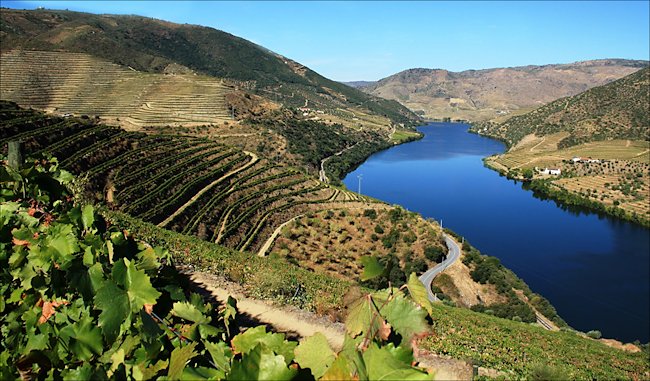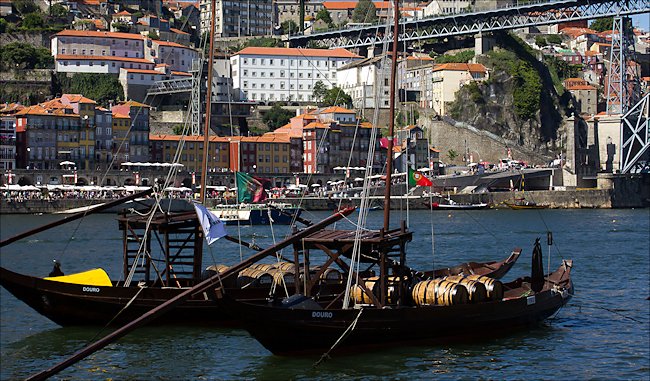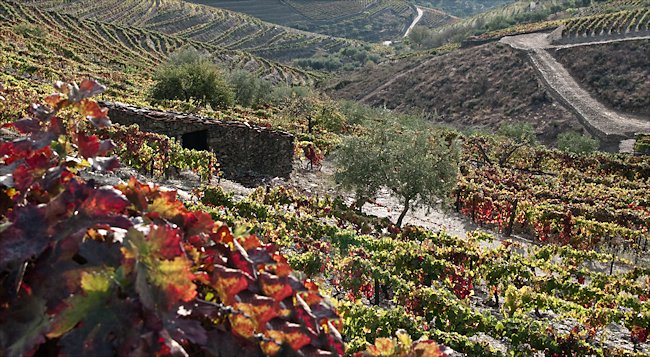The History of Port Wine
It is thanks to the Napoleonic war that Port wine became so popular and developed into a thriving industry in Porto the capital of Port wine production.

Upper Douro Valley vineyards in Portugal
Port has a fascinating history. It is produced from grapes grown on the rocky and steep slopes of the upper Douro river and some of its tributaries near the Spanish border. Farmers have grown vines on these remote sun drenched free draining remote hillsides since the Roman occupation.
The British access to red wine had a chequered past. If the French were at war with the British the flow of red wine was reduced to just a trickle. It was normally smuggled in and very expensive. In the 17th Century British traders were looking for a new source of red wine to satisfy the demand. They took a liking to the full-flavoured robust wines of Portugal.

Porto port wine barrel boats on the Douro River
Under the treaty of Methuen of 1703 the British parliament granted lower import tax duties to Portuguese wines than French and German wines.
There was a big problem. The Portuguese wines did not travel very well. One of the traders came up with the idea of adding brandy to fortify them against the rigours of their Atlantic sea journey. Later pure grape spirit was added to the fermentation process to fortify them. This was how the drink we know as Port was born.
The British loved the new drink. This caused British merchants to set up businesses in Porto. Some even established their own vineyards. Many of these British companies still trade to day like Taylors, Cockburn, Graham, Gilbert, Dow, Robertson, Smith Woodhouse and Croft.
The Upper Douro valley is separated from the Atlantic ocean and protected from its rainy winds by the mountains of the Marao. It has a climate of baking dry summers and cold winters. It has a wild and austere bleak mountain landscape. The vines are planted on manmade terraces which cling to the steep slopes.

Douro Valley Vineyards in Autumn
Under the treaty of Methuen of 1703 the British parliament granted lower import tax duties to Portuguese wines than French and German wines. There was a big problem. The Portuguese wines did not travel very well. One of the traders came up with the idea of adding brandy to fortify them against the rigours of their Atlantic sea journey. Later pure grape spirit was added to the fermentation process to fortify them. This was how the drink we know as Port was born.
The British loved the new drink. This caused British merchants to set up businesses in Porto. Some even established their own vineyards. Many of these British companies still trade to day like Taylors, Cockburn, Graham, Gilbert, Dow, Robertson, Smith Woodhouse and Croft.
The Upper Douro valley is separated from the Atlantic ocean and protected from its rainy winds by the mountains of the Marao. It has a climate of baking dry summers and cold winters. It has a wild and austere bleak mountain landscape. The vines are planted on manmade terraces which cling to the steep slopes.
When the grapes are ready they are picked by hand and pressed. The grape juice is then stored locally on the estate in large vats. It is here that the fortification process starts not in Porto.
When the yeast has changed about half the grape's natural sugar into alcohol a clean colourless brandy is added to the fermenting wine. This causes the fermentation process to stop, leaving much of the original grape sweetness in the wine.
In the spring the young wine travels 100 miles downriver to the city of Porto Port warehouses. It is here that is continues its gradual transformation into Port. Today this journey is by lorry. In times gone buy the wine was shipped down the river.
Travel books

